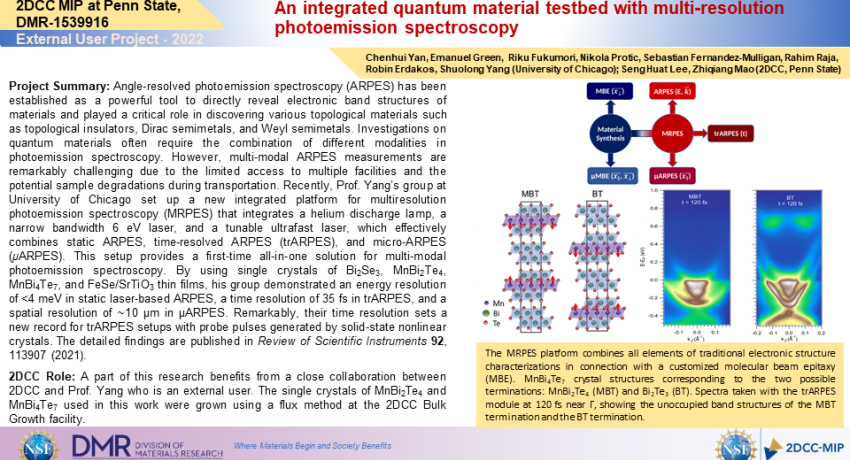Project Summary: Angle-resolved photoemission spectroscopy (ARPES) has been established as a powerful tool to directly reveal electronic band structures of materials and played a critical role in discovering various topological materials such as topological insulators, Dirac semimetals, and Weyl semimetals. Investigations on quantum materials often require the combination of different modalities in photoemission spectroscopy. However, multi-modal ARPES measurements are remarkably challenging due to the limited access to multiple facilities and the potential sample degradations during transportation. Recently, Prof. Yang’s group at University of Chicago set up a new integrated platform for multiresolution photoemission spectroscopy (MRPES) that integrates a helium discharge lamp, a narrow bandwidth 6 eV laser, and a tunable ultrafast laser, which effectively combines static ARPES, time-resolved ARPES (trARPES), and micro-ARPES (μARPES). This setup provides a first-time all-in-one solution for multi-modal photoemission spectroscopy. By using single crystals of Bi2Se3, MnBi2Te4, MnBi4Te7, and FeSe/SrTiO3 thin films, his group demonstrated an energy resolution of <4 meV in static laser-based ARPES, a time resolution of 35 fs in trARPES, and a spatial resolution of ∼10 μm in μARPES. Remarkably, their time resolution sets a new record for trARPES setups with probe pulses generated by solid-state nonlinear crystals. The detailed findings are published in Review of Scientific Instruments 92, 113907 (2021).
2DCC Role: A part of this research benefits from a close collaboration between 2DCC and Prof. Yang who is an external user. The single crystals of MnBi2Te4 and MnBi4Te7 used in this work were grown using a flux method at the 2DCC Bulk Growth facility.
What Has Been Achieved: A MRPES platform that integrates helium lamp ARPES, static laser ARPES, trARPES, μARPES, MBE, and μMBE into one system.
Importance of the Achievement: MRPES is not merely a combination of different ARPES modules, but also simultaneous probing into energy, momentum, space, and time, with uncompromised resolutions in each domain. This setup allows researchers to fully reveal the complex physics in novel quantum materials.
Unique Feature(s) of the MIP that Enabled this Achievement: Synthesis of high-quality MnBi2Te4 and MnBi4Te7 single crystals are extremely challenging due to the disorders caused by its non-stoichiometry compositions. The 2DCC has developed a protocol to grow MnBi2Te4 and MnBi4Te7 single crystals with good quality. The close collaboration between the user and the 2DCC synthesis enables this work.
(If Applicable) Publication:
Chenhui Yan, Emanuel Green, Riku Fukumori, Nikola Protic, Seng Huat Lee, Sebastian Fernandez-Mulligan, Rahim Raja, Robin Erdakos, Zhiqiang Mao, and Shuolong Yang, Rev. Sci. Instrum. 92, 113907 (2021). DOI: 10.1063/5.0072979
This work was partially supported by the NSF under Grant No. 2019131. E.G. acknowledges support from the UChicago Dean’s Scholars program. R.F. acknowledges support from the UChicago Jeff Metcalf program. The MnBi4Te7 sample preparation was supported by the National Science Foundation through the Penn State 2D Crystal Consortium-Materials Innovation Platform (2DCC-MIP) under NSF Cooperative Agreement No. DMR-1539916. We would like to thank Jonathan Sobota, Patrick Kirchmann, Hadas Soifer, Alexandre Gauthier, Brendan Faeth, Kyle Shen, Darrell Schlom, and David Awschalom for helpful discussions.
